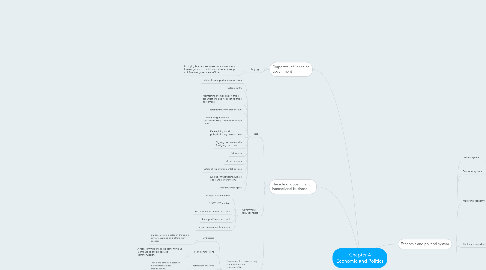
1. The business cycle
1.1. Business cycle(list)
1.1.1. The business cycle has main stages recession,trough,expansion, peak.
1.1.1.1. Recession
1.1.1.1.1. During recession phase,the economy slows down.A recession is bad for business,consumer purchasing goes down,which leads to an increase in unemployment,and results in business contracting or closing.
1.1.1.2. Through
1.1.1.2.1. This is the bottom of the cycle.Products and employment reach their lowest level.
1.1.1.3. Expansion
1.1.1.3.1. This is the stage when the company starts recovering and then grow.
1.1.1.4. Peak
1.1.1.4.1. This is the stage at the top, at this point, the economy stops expanding and begins contracting.
1.2. Economic indicators of the business cycle(list)
1.2.1. Economic indicators measure how well an economy is doing.This has three types: leading,lagging, and coincident.
1.2.1.1. Leading
1.2.1.1.1. In this part leading indicators predict here the economy is heading.
1.2.1.2. Lagging
1.2.1.2.1. Lagging indicators do not adjust until after he economy has experienced the change.
1.2.1.3. Coincident
1.2.1.3.1. Coincident indicates this is a part of trade.When economics are doing bad, countries do not import as many goods and services.But when the economy is doing goods,countries are ale to purchase more goods and services from other countries.
2. Economic of trade
2.1. Absolute advantage
2.1.1. Absolute advantage is when one country makes products or services more productively than other countries.
2.2. Opportunity cost
2.2.1. Opportunity cost is the value of what is foregone.
2.3. Comparative advantage
2.3.1. When a country has a strong hold of a company to other countries.
3. The role of government in international business
3.1. (list)
3.1.1. Establishing import and export laws
3.1.2. Setting tariffs
3.1.3. Maintaining membership in trade organizations and negotiating trade agreements
3.1.4. Establishing immigration laws
3.1.5. Determining monetary policy,including currency exchange rates
3.1.6. Determining fiscal policy,including taxation laws
3.1.7. Signing tax treaties with foreign governmen
3.1.8. Education
3.1.9. Military system
3.1.10. Establishing environmental policies
3.1.11. Building infrastructure,such as roads and sewer system
3.1.12. Ordering embargoes
3.2. Government regulations(list)
3.2.1. A registration number
3.2.2. A GST/HST number
3.2.3. A corporate income tax account
3.2.4. An import/export account
3.2.5. Payroll deduction information
3.3. Government embassies, high commissions, and consulates(list)
3.3.1. Embassies
3.3.1.1. Embassies are located in the capital city of countries and offers many services.
3.3.2. High commissions
3.3.2.1. A high commissions is the same thing as a embassies but are located commonwealth.
3.3.3. Permanent missions
3.3.3.1. These are offices located in major international organizations.
3.3.4. Consulates general
3.3.4.1. These are located in major cities that are not capitals.
3.3.5. Consulates
3.3.5.1. These are located in major cities but do not provide a major amount of services.
4. Corporate influence on government
4.1. Lobbying
4.1.1. Lobbying is a process where companies,special interest groups, or individual makes an attempt to influences government officials.
5. Economic and political system
5.1. political system
5.1.1. A political system is a form of government the country is run threw.
5.2. Economic system
5.2.1. A economic system is how the country organizes its resources and distributes goods and services to its citizens.
5.3. Marketing economy(list)
5.3.1. Marketing economy is when business,consumers, and government act independent of one another, then goods are made and sold.
5.3.1.1. Private property
5.3.1.1.1. This includes real estate, buildings,equipment,furniture,and automobiles.The owner of the property can purchase,rent ,trade,sell,give or do what ever they want with it.
5.3.1.2. Profit
5.3.1.2.1. Profit is the money you make after expenses from the risks you make.
5.3.1.3. Competition
5.3.1.3.1. Competition competes with quality, services,prices,reputation, and warranties.
5.4. Centrally planned economy(list)
5.4.1. Centrally planned economy is when decision are made mainly by the government.
5.4.1.1. Private property
5.4.1.1.1. Ownership of the property is restricted this includes factories,offices, and forms.
5.4.1.2. Profit
5.4.1.2.1. All of the profits made goes to the government.
5.4.1.3. Competition
5.4.1.3.1. The amount of competition is small,the government determines things such as price,quality,style,and amounts of goods and services.
5.5. Mixed economy(list)
5.5.1. A mixed economy is in between a marketing economy and a centrally planned economy.
5.5.1.1. Private property
5.5.1.1.1. Property that is owned by individuals, corporations,or government.For example the government owns schools,parks, and real estate.
5.5.1.2. Profit
5.5.1.2.1. The goal is to make profit,but taxed to support government projects and provide social assistance.
5.5.1.3. Competition
5.5.1.3.1. Their is strong competition threw corporations, and the government.
5.6. Political system(list)
5.6.1. The main form of political system is democracy and autocracy.
5.6.1.1. Democracy
5.6.1.1.1. A democracy means for the people.For example free and fair elections,the rule of law,free speech,the right to assembly, and freedom of religion.
5.6.1.2. Autocracy
5.6.1.2.1. An autocracy is ruled by a single individual or small group of people.
6. Classifications of economic development
6.1. Underdeveloped countries
6.1.1. These are the leased developed countries in the world also known as third world.
6.2. Developing countries
6.2.1. A developing country is country that is looking to improve literacy rates,increased access to health care and technological advancement.
6.3. Developing countries
6.3.1. A developing country is a country that is considered first world.A developing country has a high per capital income.
6.4. Gross domestic products (GDP)
6.4.1. GDP is the total goods and services produced in one country in one year.
